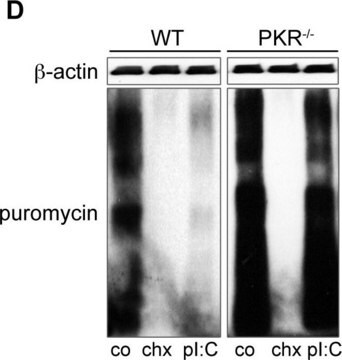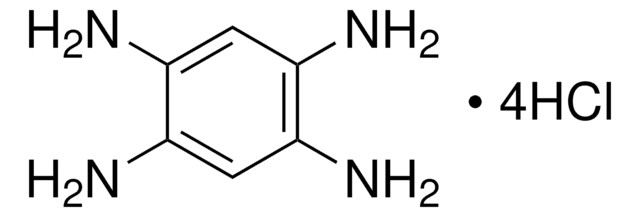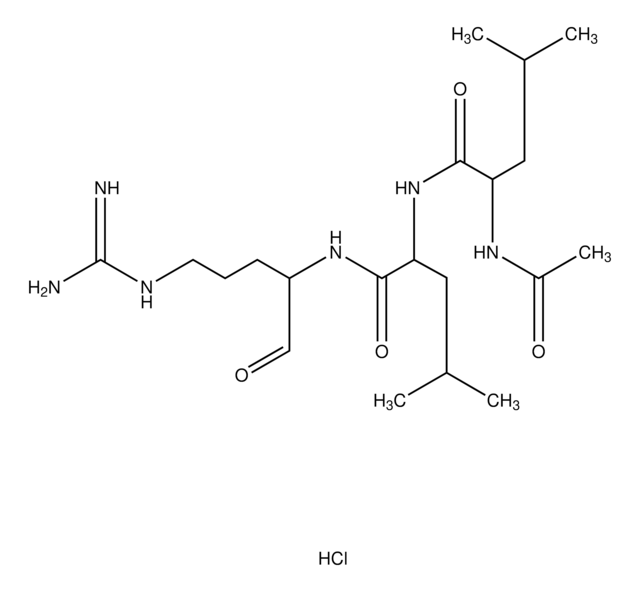P7255
Puromicina dihydrochloride from Streptomyces alboniger
≥98% (HPLC), powder
Sinónimos:
3′-[α-amino-p-metoxihidrocinnamamido]-3′-desoxi-N,N-dimetiladenosina dihydrochloride
About This Item
Productos recomendados
Nivel de calidad
Ensayo
≥98% (HPLC)
Formulario
powder
puntuación de productos alternativos más sostenibles
old score: 88
new score: 79
Find out more about DOZN™ Scoring
características de los productos alternativos más sostenibles
Atom Economy
Design for Energy Efficiency
Use of Renewable Feedstocks
Design for Degradation
Learn more about the Principles of Green Chemistry.
sustainability
Greener Alternative Product
solubilidad
H2O: 50 mg/mL
espectro de actividad antibiótica
Gram-positive bacteria
neoplastics
parasites
categoría alternativa más sostenible
Modo de acción
protein synthesis | interferes
temp. de almacenamiento
−20°C
cadena SMILES
Cl.Cl.COc1ccc(C[C@H](N)C(=O)N[C@H]2[C@@H](O)[C@@H](O[C@@H]2CO)n3cnc4c(ncnc34)N(C)C)cc1
InChI
1S/C22H29N7O5.2ClH/c1-28(2)19-17-20(25-10-24-19)29(11-26-17)22-18(31)16(15(9-30)34-22)27-21(32)14(23)8-12-4-6-13(33-3)7-5-12;;/h4-7,10-11,14-16,18,22,30-31H,8-9,23H2,1-3H3,(H,27,32);2*1H/t14-,15+,16+,18+,22+;;/m0../s1
Clave InChI
MKSVFGKWZLUTTO-FZFAUISWSA-N
¿Está buscando productos similares? Visita Guía de comparación de productos
Descripción general
Aplicación
Acciones bioquímicas o fisiológicas
Modo de resistencia: La puromicina acetiltransferasa es un gen de resistencia eficaz.
Espectro antimicrobiano: Este producto es activo frente a microorganismos grampositivos, menos activo frente a los bacilos acidorresistentes y más débilmente activo frente a los microorganismos gramnegativos. La puromicina puede impedir el crecimiento de bacterias, protozoos, algas y células de mamíferos y actúa rápidamente, matando al 99 % de las células en 2 días.
Características y beneficios
Precaución
Nota de preparación
Otras notas
Palabra de señalización
Warning
Frases de peligro
Consejos de prudencia
Clasificaciones de peligro
Acute Tox. 4 Oral
Código de clase de almacenamiento
11 - Combustible Solids
Clase de riesgo para el agua (WGK)
WGK 3
Punto de inflamabilidad (°F)
Not applicable
Punto de inflamabilidad (°C)
Not applicable
Equipo de protección personal
dust mask type N95 (US), Eyeshields, Gloves
Elija entre una de las versiones más recientes:
¿Ya tiene este producto?
Encuentre la documentación para los productos que ha comprado recientemente en la Biblioteca de documentos.
Los clientes también vieron
Artículos
Protein synthesis is a complex, multi-step process involving many enzymes as well as conformational alignment. However, the majority of antibiotics that block bacterial protein synthesis interfere with the processes at the 30S subunit or 50S subunit of the 70S bacterial ribosome.
Nuestro equipo de científicos tiene experiencia en todas las áreas de investigación: Ciencias de la vida, Ciencia de los materiales, Síntesis química, Cromatografía, Analítica y muchas otras.
Póngase en contacto con el Servicio técnico











